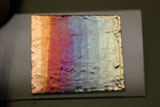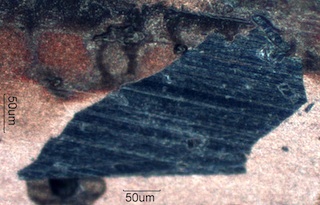Films on CopperBy way of introduction, both of these test methods monitor for growth of a film on copper when it is exposed to an oil at elevated temperature over an extended period of time. The pass/fail criteria is based on the thickness of the film that has grown at the stated temperature over the prescribed time interval. The temperature and the time of exposure has changed over the years and the conditions of the test are slightly different for these two methods, as described below. This first catagory involves the optical properties of the films alone. In the two catagories that follow we will consider films created by each of these test methods with different oils. 
(Click here for more information about the colors of thin films on copper.) (Click here for more information about the origin of the colors of thin films on copper.) ASTM D-1275BThe "B" designates a change in the temperature and the time from ASTM D-1275. The temperature was increased by ten degrees to 150 Celsius. The time was increased from 19 hours to 48 hours. This was based on the temperature and time required to make oils that passed the original test fail on the assumption that these oils caused "corrosive sulfur" failures in transformers. 
IEC 62535IEC 62535 designates a change in the temperature and the time from DIN 51353. The temperature was increased by fifty degrees to 150 Celsius. The time was increased from 18 hours to 72 hours and a layer of paper was added because it created more reliable results. This was based on the temperature and time required to make oils that passed the original test fail on the assumption that these oils caused "corrosive sulfur" failures in transformers. |

